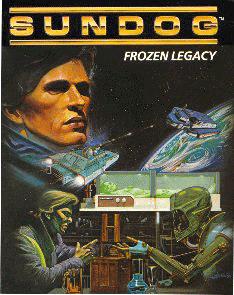
SunDog: Frozen Legacy is a 1984 space trading and combat simulator video game. SunDog was first developed for the Apple II, with version 1.0 being released in March 1984, and version 1.1 released three weeks later. Version 2.0, which included enhancements and improved performance, was released in October, 1984. An enhanced version was released for the Atari ST in December 1985.

Puerto Rico is a Euro-style board game designed by German designer Andreas Seyfarth and published in 2002 in a German-language edition by Alea. Players assume the roles of colonial governors on the island of Puerto Rico during the age of Caribbean ascendancy. Puerto Rico was the highest-rated game on the board game website BoardGameGeek for over five years, until it was surpassed by Agricola. The aim of the game is to amass victory points in two ways: by exporting goods and by constructing buildings.

San Juan is a card game designed by Andreas Seyfarth and published in 2004 by Alea in German and by Rio Grande Games in English. The game is derived from the board game Puerto Rico, and takes its name from San Juan, capital of Puerto Rico.
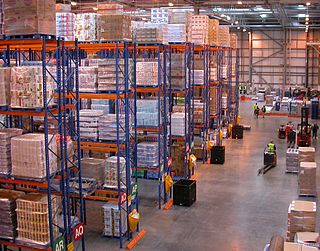
A distribution center for a set of products is a warehouse or other specialized building, often with refrigeration or air conditioning, which is stocked with products (goods) to be redistributed to retailers, to wholesalers, or directly to consumers. A distribution center is a principal part, the order processing element, of the entire order fulfillment process. Distribution centers are usually thought of as being demand driven. A distribution center can also be called a warehouse, a DC, a fulfillment center, a cross-dock facility, a bulk break center, and a package handling center. The name by which the distribution center is known is commonly based on the purpose of the operation. For example, a "retail distribution center" normally distributes goods to retail stores, an "order fulfillment center" commonly distributes goods directly to consumers, and a cross-dock facility stores little or no product but distributes goods to other destinations.

Spelljammer: Pirates of Realmspace is a video game for MS-DOS released by Strategic Simulations in 1992. It is a Dungeons & Dragons PC video game using the Advanced Dungeons & Dragons, Second Edition rules, and the Spelljammer setting. Spelljammer was programmed and designed by Cybertech Systems.

X3: Reunion is a single-player space trading and combat video game developed by Egosoft and published by Deep Silver. It is the third installment in the X series and the sequel to X2: The Threat (2003), which in turn followed X: Beyond the Frontier (1999). X3: Reunion was released originally for Windows in 2005. The game was later ported to Mac OS X and Linux.
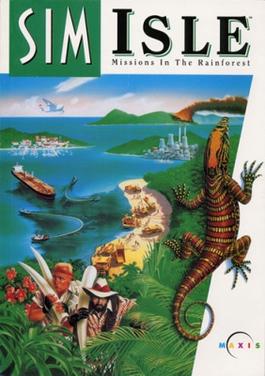
SimIsle: Missions in the Rainforest is a construction and management simulation game published by Maxis in 1995. Though it was not developed by Maxis, they still referred to it as a "software toy" instead of a "video game" because it remained faithful to the philosophy of the company.
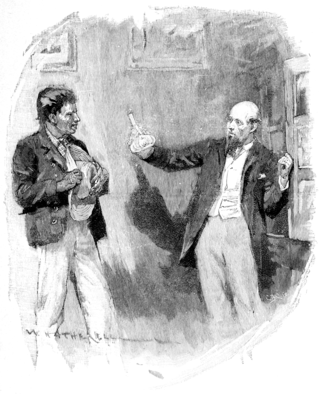
"The Bottle Imp" is an 1891 short story by the Scottish author Robert Louis Stevenson usually found in the short story collection Island Nights' Entertainments. It was first published in the New York Herald and Black and White magazine. In it, the protagonist buys a bottle with an imp inside that grants wishes. However, the bottle is cursed; if the holder dies bearing it, his or her soul is forfeit to hell.

A freight rate is a price at which a certain cargo is delivered from one point to another. The price depends on the form of the cargo, the mode of transport, the weight of the cargo, and the distance to the delivery destination. Many shipping services, especially air carriers, use dimensional weight for calculating the price, which takes into account both weight and volume of the cargo.

Twilight Imperium is a strategy board game produced by Fantasy Flight Games in the genre of science fiction and space opera. It was designed by Christian T. Petersen and was first released in 1997. The game is in its fourth edition (2017), which has large changes over previous editions. It is known for the length of its gameplay, and its in-depth strategy.
Railways of the World is a railway-themed board game designed by Martin Wallace and Glenn Drover and published by Eagle Games. It is a simplified version of Wallace's earlier railway-themed game Age of Steam. The game, first released in 2005, was originally named Railroad Tycoon after the video game series of the same name, featuring box art based on the third entry in the video game series. After the license to use the Railroad Tycoon name expired, the board game has been published under its current Railways of the World title since 2009. It takes place in the eastern United States in 1830. Each player takes charge of a pioneering new railway company.

Starship Catan is a two-player card game, loosely based on the Starfarers of Catan board game. As a member of the Catan family of games, it is designed by Klaus Teuber, and distributed by Kosmos in German and Mayfair Games in English.

In shipping, break-bulk, breakbulk, or break bulk cargo, also called general cargo, is goods that are stowed on board ships in individually counted units. Traditionally, the large numbers of items are recorded on distinct bills of lading that list them by different commodities. This is in contrast to cargo stowed in modern intermodal containers as well as bulk cargo, which goes directly, unpackaged and in large quantities, into a ship's hold(s), measured by volume or weight.

Pardus is a graphical browser-based MMORPG written in PHP and C/C++ and set in a futuristic universe where players interact and compete in space. It is a persistent-universe, open-ended game with a player-driven economy. Players travel through hundreds of "sectors" or solar systems while trading, building or battling with Non-Player Characters (NPCs) and other players. There are dozens of spacecraft models in Pardus, which can be customized with different weapons, armor and other equipment. Pardus characters do not have a defined 'class'.
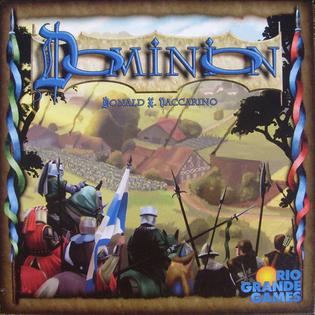
Dominion is a card game created by Donald X. Vaccarino and published by Rio Grande Games. Originally published in 2008, it was the first deck-building game, and inspired a genre of games building on its central mechanic. Each player begins with a small deck of cards, which they improve by purchasing cards from a common supply that varies from game to game. Cards can help the player's deck function, impede their opponents, or provide victory points. As of December 2022, fifteen expansions to the original Dominion have been released.
Glenn Drover's Empires: The Age of Discovery is the first of the Glenn Drover's Empires board games, created by Glenn Drover.

Space Bucks was a space trading simulation developed by Impressions Games and published by Sierra On-Line. The game focuses on the creation of a trade empire against several computer controlled opponents. Victory is achieved through a combination of infrastructure investments, the stock market, piracy, sabotage, and of course trade goods.
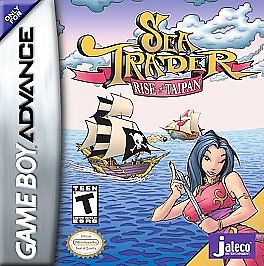
Sea Trader: Rise of Taipan is a simulation video game developed and published by Jaleco Entertainment's American division. The game was released exclusively in North America in 2002 for the Game Boy Advance. In Sea Trader, the player controls a ship and tries to build a trading empire by selling goods between different ports. Reception was mixed, with praise for its addictive nature but criticism of its dated graphics and somewhat bare-bones gameplay.
Mombasa is a 2015 Euro-style board game by Alexander Pfister. The theme is the rivalry of four trading companies in Africa. Players buy shares in the companies and expand them to their advantage, aiming to build the most valuable portfolio. Game mechanics include deck building and worker placement. Mombasa won the 2016 Deutscher Spielepreis.
















